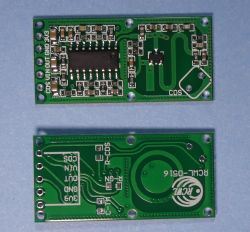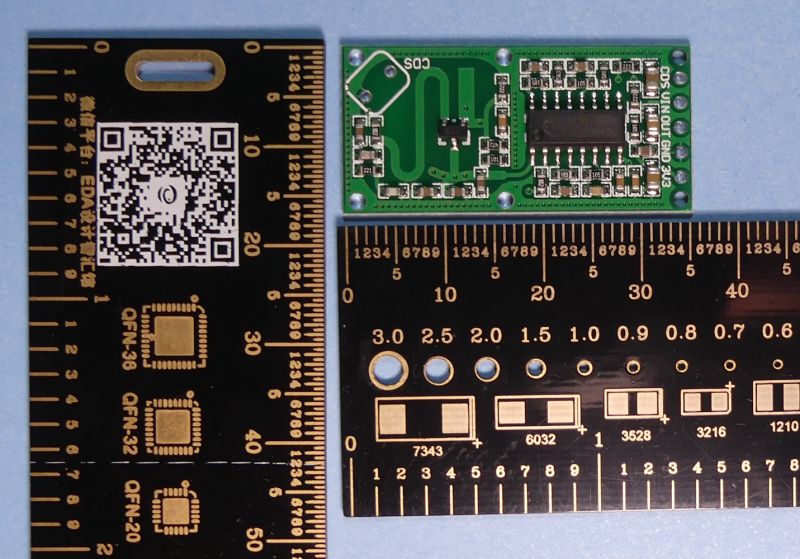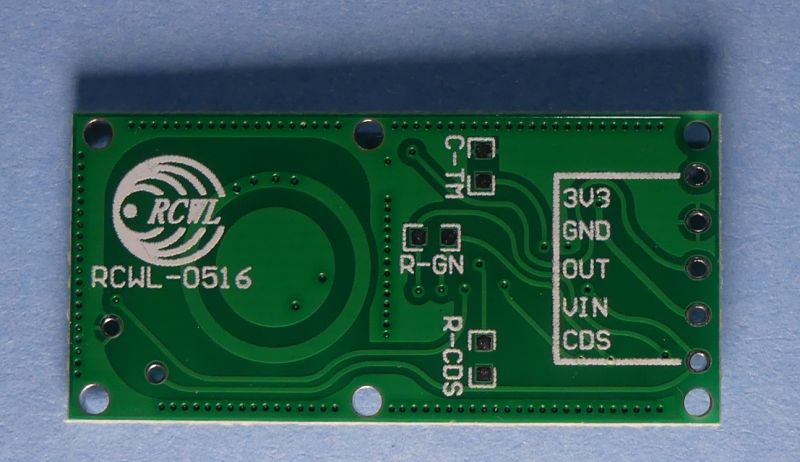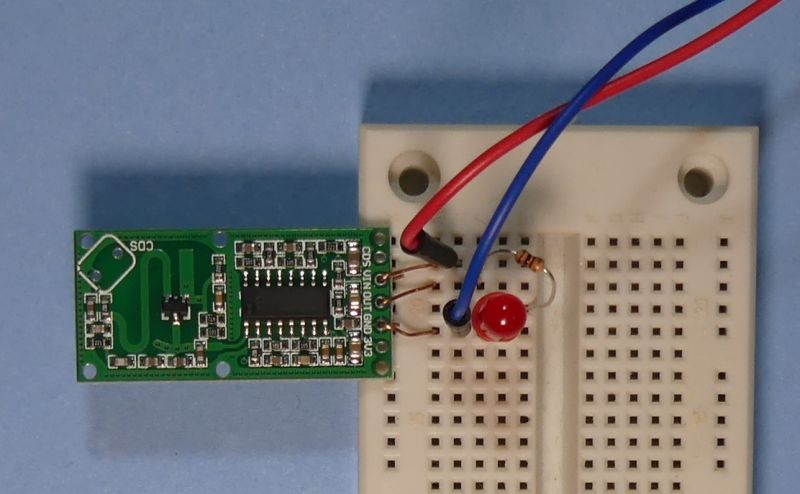FAQ
TL;DR: RCWL-0516 detects motion through wooden shelves at 5–7 m while drawing only 15 mW of power ("Microwaves penetrate wooden doors and thin walls" [Elektroda, TechEkspert, #21182319; #21182793]). Ideal for low-power presence sensing, yet susceptible to cross-room or RF interference.
Why it matters: It offers a £5 microwave alternative to PIR where line-of-sight is blocked.
Quick Facts
• Supply voltage: 4–28 V DC, 3 mA at 5 V [Elektroda, TechEkspert, post #21182319]
• Default range: 5–7 m front/back of PCB plane [Elektroda, TechEkspert, post #21182319]
• Carrier frequency: approx. 3.18 GHz (ISM band) [Elektroda, TechEkspert, post #21182319]
• Output pulse: ~2 s (extend with C-TM) [Elektroda, TechEkspert, post #21182319]
• Module price: ~£5; 24 GHz versions ≈£20 [Elektroda, TechEkspert, post #21184978]
What makes the RCWL-0516 different from a PIR sensor?
It emits 3 GHz microwaves and measures Doppler shifts, so it “sees” motion through wood, cardboard, or thin walls, unlike PIRs that need a clear thermal line-of-sight [Elektroda, TechEkspert, post #21182319]
How far can the module detect human movement by default?
Expect 5–7 m straight ahead of the board; side sensitivity is lower because the antenna pattern is planar [Elektroda, TechEkspert, post #21182319]
How much RF energy does it radiate— is it safe?
At 5 V the module draws 3 mA, so radiated power is around 15 mW— well below Wi-Fi or phone levels [Elektroda, TechEkspert, post #21182319]
Why do two RCWL-0516 boards interfere with each other?
They share the same 3 GHz ISM band and lack frequency hopping; two nearby transmitters beat together, masking Doppler shifts [Elektroda, TechEkspert, post #21182319]
Can Wi-Fi or ESP32 radios cause false triggers?
Yes; users report continuous false alarms when a Wi-Fi router operates nearby because both occupy 2.4–2.5 GHz [Elektroda, kaworu, post #21183522]
How do I shorten the detection range for confined spaces?
Add a 120 Ω resistor in parallel with R9 to drop range to 30–40 cm without other changes [Elektroda, kasa, post #21191138]
3-Step How-To: Reduce range under stairs
- Locate R9 (1 MΩ) on the PCB.
- Solder a 120 Ω resistor directly across R9 pads.
- Power up and verify the new 30–40 cm trigger distance [Elektroda, kasa, post #21191138]
What if my board only reacts within 2 cm?
Such behavior suggests a defective module or strong nearby RF source; try another unit and test in a shielded room [Elektroda, HD-VIDEO, #21229742; TechEkspert, #21229950].
Does adding shielding improve directionality?
Placing a grounded metal plate behind the PCB blocks back-lobes and reduces rear sensitivity; leave the sensing side open [general RF practice].
Which supply pins do I connect?
VIN to 4–28 V DC, GND to ground. 3.3 V pin outputs ~100 mA max for logic supply; OUT is the motion-high signal [Elektroda, TechEkspert, post #21182319]
Can I add daylight lockout?
Yes; wire a photoresistor between CDS and GND. Adjust resistor R-CDS to set the lux threshold [Elektroda, TechEkspert, post #21182319]
Are higher-frequency microwave sensors better?
24 GHz units cost ≈£20 and offer finer resolution and smaller antennas, but similar 5–7 m indoor range and greater attenuation through walls [Elektroda, TechEkspert, post #21184978]
What extreme sensitivity issues should I expect?
Edge cases include detection through plasterboard into corridors, leading to false alarms—“movement in the neighbouring room can be detected” [Elektroda, TechEkspert, post #21182793]
Is it suitable for security alarms?
For alarms use a proven PIR; the RCWL-0516 is “better as a presence detector” due to jamming risk from a second £5 board [Elektroda, TechEkspert, post #21182793]








Comments
I am constantly puzzled by the safety of microwave detectors (it's all about radiation). They used to have to be switched on during standby, but now supposedly the radiation power has dropped to negligible.... [Read more]
This circuit draws 3mA at 5V so the power is low, I am more concerned about littering the bandwidth than safety. False alarms are mainly due to motion detection outside the area of the room being monitored.... [Read more]
Nice chip but prone to interference, doesn't work properly near another transmitter operating in a similar band (Wi-Fi router, ESP8266, ESP32), lots of false triggers. I haven't tested the sensitivity... [Read more]
I see that microwave sensors on 24GHz are slightly more expensive ~£20 ranges similar, I wonder how about sensitivity and immunity to interference. Others work on 10.525GHz. Interestingly, there are... [Read more]
And is there any point in partially shielding such detectors? E.g. will adding a grounded plate to the back of the detector, or even putting it in a metal box without a single wall, improve the directionality... [Read more]
I wanted to add that adding a 120 Ω resistor in parallel to R9 on the board reduces the range to 30-40 cm without any combination. It has worked for me for 3 years without any false alarms, placed under... [Read more]
. And that's interesting. I have installed laser sensors by the stairs, but the above "patent" might be better. Can the sensor be set to react even before stepping on the step? [Read more]
It would have to be tried, I haven't had the need. It could be that there will be false alarms, really putting your foot down is enough. [Read more]
Yes, I've come across microwave motion sensors like the RCWL-0516. These sensors, unlike traditional PIR (Passive Infrared) sensors, work based on the Doppler effect, making them capable of detecting motion... [Read more]
And I have a question for this detector, what kind of range do they have, because I have two of them and.... from 2 cm from the detector react to movement. On the value of the power supply the range does... [Read more]
2cm it looks like some damaged modules or strong RF background? [Read more]